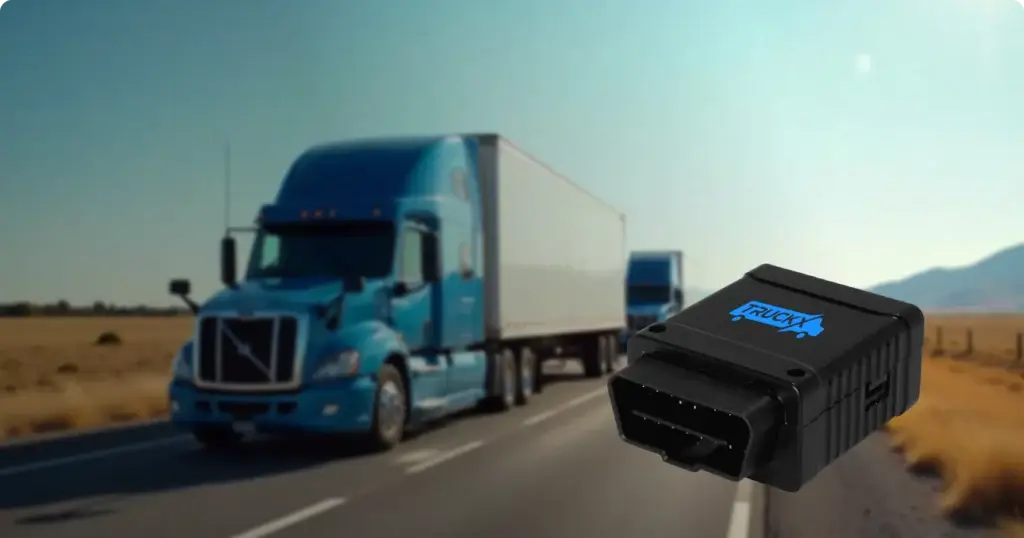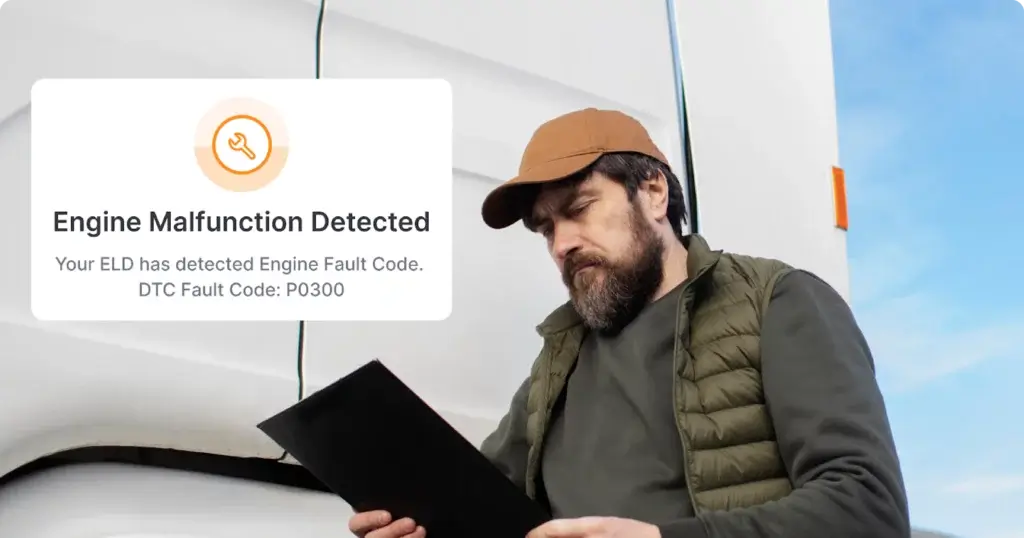In 2023, the United States Department of Transportation (DoT) conducted nearly 2 million truck roadside inspections and filed more than 3 million vehicle violations, out of which 673,661 (over 20%) were reported Out-of-Service (OOS) violations. Imagine the loss fleets and carriers have to endure: millions of dollars of fines and lost revenue due to out-of-service, repair costs, and relationship damage — all this just because of insufficient DVIR reporting.

What is a DVIR?
A Driver Vehicle Inspection Report (DVIR) indicates that the driver has inspected the CMV or commercial motor vehicle before or after a trip. It is a digital report of any detected or fixed vehicle defects.
Imagine the damage a sudden tire burst or an inoperable brake can cause not just to your vehicle, operational efficiency, and driver but also to other vehicle’s, especially in an era of unprecedented insurance claims. These inspections ensure that the vehicle is at its required maintenance level and does not threaten the driver’s or vehicle’s safety on the road.
Why is a DVIR required?
First things first, as mandated by the United States Department of Transportation (DoT), Federal Motor Carrier Safety Administration (FMCSA), and under federal law 49 CFR 396.11 and 396.13, a commercial vehicle driver should conduct vehicle inspections daily and file DVIRs only if there are any defects. However, if you operate in Canada, then to comply with Canadian National and Provincial regulations, U.S.-based motor carriers must complete and retain DVIRs when operating in Canada regardless of whether or not defects are noted.
Additionally, if you violate the mandate, hefty fines could derail your business. These fines include:
- Failing to complete the inspection can incur a maximum civil penalty of $1,270 daily.
- Knowingly changing, destroying, or falsifying the DVIR can incur a maximum civil penalty of $12,695.
- And for each violation of no recordkeeping, you will incur a maximum penalty of $15,419.
Furthermore, it helps drivers or fleet managers identify any vehicle-related hazards. It mitigates the risk of accidents that could severely harm drivers and cargo. The report determines whether or not the vehicle is in a sufficiently maintained state to drive on the road. Also, it identifies if there is some damage that the vehicle sustained during the trip.
What are essential DVIR components?
So, what is the checklist one should adhere to? Well, according to the FMCSA, these are some parts that drivers should necessarily inspect before hitting the road. These parts include:
- Service brakes and trailer brake connection
- Parking or hand brake
- Lighting devices and reflectors
- Steering mechanisms
- Horns
- Coupling devices
- Tires
- Wheels and rims
- Windshield wipers
- Mirrors (including rearview mirrors)
- Emergency equipments
These are some of the basic components that drivers should focus on. However, drivers should not limit their inspection to these parts only.
When is DVIR required?
Pre-trip Driver Vehicle Inspection Report
When the driver examines the vehicle before starting the trip, the inspection is called a pre-trip driver vehicle inspection report (pre-trip DVIR). Drivers must check components like fuel tanks, brakes, lights, horns, and tires to ensure vehicle safety.
In case of multiple-day trips, the driver should assess the vehicle conditions and safety protocols daily and file the DVIRs in case of any defects. This mitigates safety issues and shields the driver from violating laws and regulations.
Post-trip Driver Vehicle Inspection Report
FMCSA Federal Law 49 CFR 396.11 states that a CMV or commercial motor vehicle must undergo a post-trip walk-around inspection. If you operate more than one vehicle daily, you must conduct the vehicle inspection for both CMVs separately. And file vehicle inspection reports only if there are some defects.
Conducting a post-trip examination helps drivers and fleet managers determine if any damage occurred during the trip. Identifying and repairing the issue is essential before the next workday.
Additionally, it removes any delay that the previous day’s damage could cause, reducing the impact on efficiency and timely delivery. It also helps you better understand your vehicle’s health condition.
Once you find the defect, report it and let your fleet manager or motor carrier know about it. It will ensure prompt damage control and repair.
Benefits of a DVIR
By filing the report, a driver ensures the vehicle does not sustain any hazardous defects. Regular pre-and post-trip inspections help drivers identify and prevent defects before they cause massive damage.
Moreover, the driver vehicle inspection report offers a substantial cost savings opportunity by reducing and avoiding large-scale repairs. It also reduces unexpected downtime, which improves timely delivery. The inspection optimizes vehicle performance, maximizing productivity and extending the assets’ lifespan.
Implementation Challenges
1. Unneeded / Waste of Time
One of the biggest challenges is driver compliance. They might consider these inspection reports as unneeded and a waste of time.
2. Paperwork and Recordkeeping
Filing and reporting inspection reports is tedious and full of paperwork. So, what’s the solution? Electronic or eDVIR makes reporting efficient and removes all the unnecessary paperwork.
3. Manual Reporting
Filing the report manually is tedious, so what’s the alternative? Seamlessly complete your DVIR workflow on the TruckX ELD Pro Driver App.
Advanced DVIR with TruckX ELD Pro
- Automatic Defect Carry-Over: If a previous driver reported a defect in the vehicle during his inspection, the next driver who connects with the vehicle will be able to see the existing defects. Once solved, the driver can mark it resolved.
- Safe/Not Safe to Drive Alerts: Suppose a driver marks a vehicle as unsafe, and someone subsequently attempts to drive it. In that case, the TruckX ELD Pro Driver App immediately alerts them that it is unsafe to continue their trip and that they must fix the defect before driving the vehicle.
- Upload Walk-around Images: TruckX’s driver logbook app allows you to take general walk-around images and upload them, proving that the inspection has been done and documenting the vehicle’s condition.
DVIR Best Practices
1. Set a Standard Process
Although there is no defined process for filing the inspection report, you must set one to avoid discrepancies. You can consider the following steps:
- Thoroughly examine the vehicle’s exterior and interior.
- Note down or document if the vehicle has any defects.
- Then, file the report. Label the defects (if any) and let the supervisor know. Also, if there are no defects, ensure the vehicle inspection report reaches the specified department.
- After reporting the defects, take the corrective measures promptly. Schedule its repair, analyze the root cause, and learn more about the defect.
2. Educate your Driver
Inform your driver of the significance of filing it. Schedule the training while onboarding them, and inform them of what key components they are responsible for inspecting. Educate them about the benefits of keeping a filed vehicle inspection report and how non-compliance can lead to thousands of dollars of fines.
3. Use eDVIR
Manually filing the inspection report can be tiresome and time-consuming. Using technology can streamline the inspection process and increase efficiency:
- Use DVIR Apps: TruckX’s driver logbook app allows you to conduct vehicle inspections through your mobile device, take snapshots, and input data directly into the digital DVIR form.
- Use ELDs: The TruckX Electronic Logging Device (ELD) connects to the vehicle engine and automatically fetches and records data related to vehicle faults. You can digitally access any vehicle codes directly from your driver logbook or with one click from your Admin web portal.
4. Monitor and Analyze Data
Keeping and analyzing the reported data is crucial if you are a fleet manager or an owner-operator. Total repairs done, maintenance data, and completed inspection reports are required during compliance checks and audits.
Conclusion
One crucial thing you can infer from this blog is that the Driver Vehicle Inspection Report is essential for your vehicle. You would not want to get into legal trouble, pay hefty fines, and risk losing the license. However, if you think filing DVIRs manually is a hassle, you can start using TruckX’s driver logbook app, which allows you to file the inspection reports directly from the FMS or through the app.
Reach out to our experts and learn how TruckX’s software simplifies DVIR and helps you navigate the complexities of an FMS.
FAQs
When should you complete and sign a DVIR?
According to federal law and FMCSA regulations, drivers must conduct pre- and post-trip vehicle inspections. If they find any defects or damages in the vehicle, they must file a DVIR. Not filing and violating the law may result in hefty fines.
What is a 15-minute pre-trip inspection?
A driver should spend 15 minutes before hitting the road performing the pre-trip inspection. During this time, they must take a vehicle overview and check for the engine compartment and its startup, and do in-cab checkups. Look if lights and turn signals are working fine.
What is an DVIR essential checklist?
A Driver Vehicle Inspection Report checklist contains all the critical components drivers must check before and after their trips. This checklist ensures the optimum condition of your CMV.
Who’s exempt from the regulation?
Section 396.11 stipulates that the following vehicles are exempt from DVIR regulation: all private vehicles carrying passengers not as a business, motor carriers with only commercial motor vehicles, and driveway towaway.









